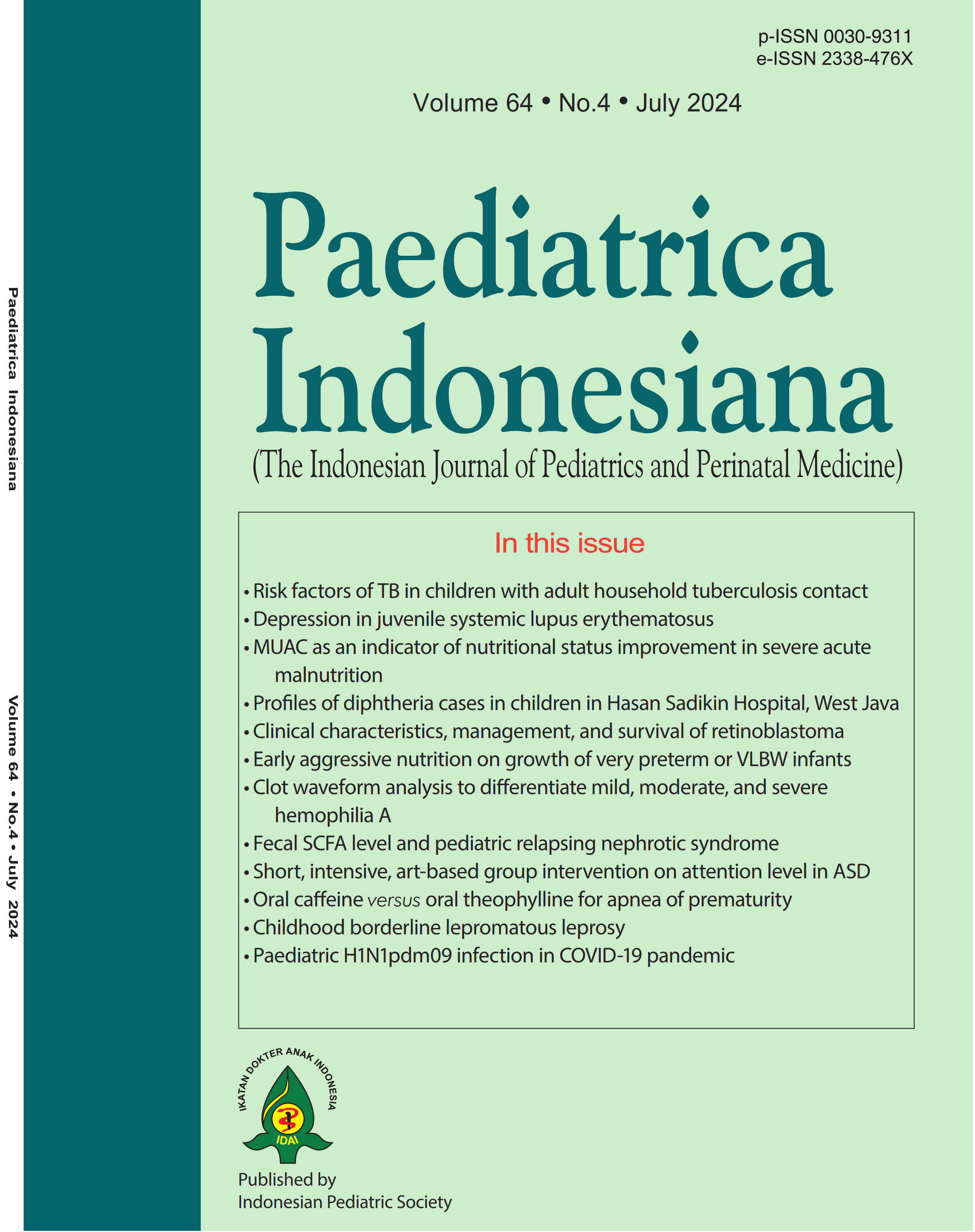H1N1pdm09 infection in children: A case report of reemerging disease in COVID-19 pandemic
DOI:
https://doi.org/10.14238/pi64.4.2024.363-8Keywords:
H1N1pdm09 infection, Influenza A, PandemicAbstract
An outbreak of H1N1 infection was first declared by the World Health Organization in 2009 and confirmed in the post-pandemic phase in 2010. Amid the COVID-19 pandemic, we found a confirmed case of H1N1pdm09 in Bunda Women and Children Hospital Jakarta. A 13-year-old boy was referred to our hospital after four days of hospitalization due to worsening tachypnea following a productive cough and fever. The patient had severe dyspnea with inspiratory effort and oxygen desaturation to 80%, therefore admitted to our pediatric intensive care unit. On physical examination, the patient had increased work of breathing, looked irritable, had a respiratory rate of about 40x/minute with non-rebreathing mask support, and crackles were heard in both lungs. Chest x-ray showed right bronchopneumonia. There was a history of a generalized seizure for less than 1 minute, which stopped spontaneously in previous hospital care. The patient was diagnosed with mucopolysaccharidosis at age six years old and has never received enzyme replacement therapy. Laboratory results revealed thrombocytopenia, leukopenia, neutrophilia, monocytosis, high c-reactive protein and procalcitonin, and elevated liver enzymes. The investigation of etiology was performed using the respiratory panel test and showed a positive real-time polymerase chain reaction for H1N1pdm09 and Influenza A. The patient was given oxygen therapy with a high-flow nasal cannula with an oxygen fraction of 40% and a flow of 20 liters per minute, fluid maintenance while fasting, antibiotics, inhaled beta-2 agonists, and a neuraminidase inhibitor (oseltamivir). The patient's clinical and laboratory markers improved on the third day of treatment, and he was discharged two days later.
References
2. Ikatan Dokter Anak Indonesia. Waspada flu dan flu burung. Available at: https://www.idai.or.id/artikel/seputar-kesehatan-anak/waspada-flu-dan-flu-burung. Accessed 2022 July 21.
3. McAuley JL, Gilbertson BP, Trifkovic S, Brown LE, McKimm-Breschkin JL. Influenza virus neuraminidase structure and functions. Front Microbiol. 2019;10(JAN). DOI: 10.3389/fmicb.2019.0003
4. Baldo V, Bertoncello C, Cocchio S, Fonzo M, Pillon P, Buja A, et al. The new pandemic influenza A/(H1N1)PDM09 virus: Is it really “new”? J Prev Med Hyg. 2016;57(1):E19–22.
5. Taubenberger JK, Reid AH, Lourens RM, Wang R, Jin G, Fanning TG. Characterization of the 1918 influenza virus polymerase genes. Nature. 2005;437:889–93
6. Rambaut A, Pybus OG, Nelson MI, Viboud C, Taubenberger JK, Holmes EC. The genomic and epidemiological dynamics of human influenza A virus. Nature. 2008;453:615–9. DOI: 10.1038/nature06945
7. Guy RC. Report of the Committee on Infectious Diseases. American Academy of Pediatrics. 2005. 630–631 p. DOI: 10.3201/eid1212.061045
8. Bartholomeusz A, Locarnini S. Associated With Antiviral Therapy. Antivir Ther. 2006;55:52–5. DOI: 10.1002/jmv.20608.
9. Murniati D, Giriputro S. Manfaat Oseltamivir Terhadap Perbaikan Klinis Kasus Pandemi Influenza Baru A (H1N1) 2009 Anak. Sari Pediatri. 2016;14:309.
10. de Ruijter J, Broere L, Mulder MF, van der Ploeg AT, Rubio-Gozalbo ME, Wortmann SB, et al. Growth in patients with mucopolysaccharidosis type III (Sanfilippo disease). J Inherit Metab Dis. 2014;37:447–54. DOI: 0.1007/s10545-013-9658-3
11. McBride KL, Flanigan KM. Update in the Mucopolysaccharidoses. Semin Pediatr Neurol. 2021;37:100874. DOI: 10.1016/j.spen.2021.100874
12. Bagdure D, Curtis DJ, Dobyns E, Glodé MP, Dominguez SR. Hospitalized children with 2009 pandemic influenza A (H1N1): Comparison to seasonal influenza and risk factors for admission to the ICU. PLoS One. 2010;5:e15173. DOI: 10.1371/journal.pone.0015173
13. Launes C, García-García JJ, Martínez-Planas A, Moraga F, Soldevila N, Astigarraga I, et al. Clinical features of influenza disease in admitted children during the first postpandemic season and risk factors for hospitalization: A multicentre Spanish experience. Clin Microbiol Infect. 2013;19:E157-62. DOI: 10.1111/1469-0691.12106
14. QIAGEN. QIAstat-Dx® respiratory SARS-CoV- 2 panel instructions for use (handbook). Hilden: QIAGEN GmbH; 2020. p. 1–136.
15. Seema Jain, Williams DJ, Arnold SR, Ampofo K, Bramley AM, Reed C. Community-Acquired Pneumonia Requiring Hospitalization among U.S. Children. N Engl J Med. 2015;372:835–45. DOI: 10.1056/NEJMoa1405870
16. Saunders-Hastings PR, Krewski D. Reviewing the history of pandemic influenza: Understanding patterns of emergence and transmission. Pathogens. 2016;5:66. DOI: 10.3390/pathogens5040066
17. Alves VRG, Perosa AH, Luna LK de S, Cruz JS, Conte DD, Bellei N. Influenza A(H1N1)PDM09 infection and viral load analysis in patients with different clinical presentations. Mem Inst Oswaldo Cruz. 2020;115:1–5. DOI: 10.1590/0074-02760200009
18. Ratre YK, Vishvakarma NK, Bhaskar LVKS, Verma HK. Dynamic propagation and impact of pandemic influenza A (2009 H1N1) in children: A detailed review. Curr Microbiol. 2020;77:3809–20. DOI: 10.1007/s00284-020-02213-x
19. Myles PR, Semple MG, Lim WS, Openshaw PJM, Gadd EM, Read RC, et al. Predictors of clinical outcome in a national hospitalised cohort across both waves of the influenza A/H1N1 pandemic 2009-2010 in the UK. Thorax. 2012;67:709–17. DOI: 10.1136/thoraxjnl-2011-200266
20. Frenck RW, Klein NP, Kitchin N, Gurtman A, Absalon J, Lockhart S, et al. Safety, Immunogenicity, and Efficacy of the BNT162b2 Covid-19 Vaccine in Adolescents. N Engl J Med. 2021;385:239–50. DOI: 10.1056/NEJMoa2107456
21. Ruf BR, Knuf M. The burden of seasonal and pandemic influenza in infants and children. Eur J Pediatr. 2014;173:265–76. DOI: 10.1007/s00431-013-2023-6.
22. Lee IK, Liu JW, Wang L, Yang KD, Li CC, Eng HL. 2009 pandemic Influenza A (H1N1): Clinical and laboratory characteristics in pediatric and adult patients and in patients with pulmonary involvement. Influenza Other Respi Viruses. 2012;6:152–61. DOI: 10.1111/j.1750-2659.2012.00410.x
Downloads
Published
How to Cite
Issue
Section
License
Authors who publish with this journal agree to the following terms:
Authors retain copyright and grant the journal right of first publication with the work simultaneously licensed under a Creative Commons Attribution License that allows others to share the work with an acknowledgement of the work's authorship and initial publication in this journal.
Authors are able to enter into separate, additional contractual arrangements for the non-exclusive distribution of the journal's published version of the work (e.g., post it to an institutional repository or publish it in a book), with an acknowledgement of its initial publication in this journal.
Accepted 2024-09-03
Published 2024-09-03


















